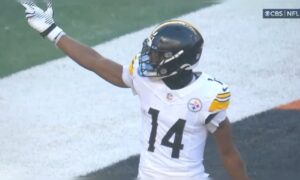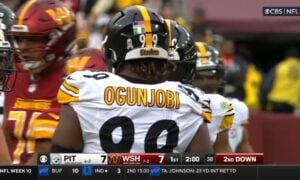By Alex Kozora
Part Two of our two-part series recapping the Pittsburgh Steelers inaugural 1933 season. This part is a little bit shorter than part one but that’s due to most games being on the road and it produced shorter game reports.
Game #5: October 15th, 1933: Green Bay Packers (47-0 Loss)
This tied for the second-largest margin of defeat in team history. Only a 51-0 loss in the opening game of the 1989 season to the Cleveland Browns was worse.
On this day, the Pirates would not advance past the opposing 40. Yikes.
The game was on the road so the write-ups come from national services, the Press using the United Press and the PPG the AP. As you’d expect, they’re shorter and less detailed.
Clark Hinkle drew first blood for the Packers, scoring on a one-yard plunge. The Packers found the end zone three times in the second. A Bob Monnett six yard run (extra point missed) along with Charles “Buckets” Goldenberg’s 65 yard interception return followed by a two yard run. At the half, Green Bay led 27 zip.
It wouldn’t get much easier in the second half. Hank Bruder scored on a 53 yard run on the first play of the third. Monnett would get his second of the day, a 12 yard run later in the period. The onslaught finally came to a close in the fourth Wuret Engleman’s (God I love these names) 49 yard run stemming from a hook and ladder type play.
The box score shows a large number of substitutions on each side, predictable given the blowout.
BOX SCORE
PIT: 0 0 0 0 = 0
GB: 7 20 13 7 = 47
Game #6: October 22nd, 1933 – Cincinnati Reds (0-0 Tie)
Oh, ties. The first in franchise history. Another road game so information is scarce. The headline in one paper led with the much more popular Pitt Panthers, noting their loss to Minnesota.
Rainy and muddy conditions contributed to the lack of scoring.
But the Reds had a great chance to win the game in the last five minutes. Algy Clark missed two field goals over that span, making him the original Doug Brien.
The Pirates’ best chance of scoring came on a Jimmy Clark 55 yard interception return, taking it to the opponent’s 19. But alas, the team came away without points.
BOX SCORE
PIT: 0 0 0 0 = 0
CIN: 0 0 0 0 = 0
CIN: 7 First Downs, 131 total yards, 60 penalized
PIT: 3 First Downs, 68 total yards, 15 penalized
Game #7: October 28th, 1933 – Boston Redskins (16-14 Win)
The first true upset in team history and its last victory of the ’33 campaign. The Press remarked the Pirates were “outplayed and out-gained in every quarter” but used two long drives plus a field goal in the victory.
The game took place in front of a crowd of 7500 at Fenway Park.
Boston got off to a hot start, scoring within the first two minutes. Former Redskin Ed Westerfall had his punt blocked and Cliff Battles took advantage, running into the end zone two plays later. PAT was true, 7-0 lead Boston.
Pirates found the end zone in the second when Tony Holm hit Moss on a 30 yard pass/ It was Moss’ second touchdown of the year. Mose Kelsch’s XP missed and Boston still led 7-6.
Pirates got on the board again before half time thanks to an interception deep in Redskin territory. Paul Engebresten kicked a FG, why he was asked to I’m not sure, but it was good, giving the Pirates a 9-7 lead into the intermission.
Pittsburgh would add a splash play in the third. Holm to Westerfall for a 60 yard TD. Westerfall cleans things up with the PAT and the Pirates built a 16-7 advantage.
Boston’s Louie Weller would cap off an 88 yard drive with a rushing touchdown in the fourth but the Pirates held on for the “W.”
BOX SCORE
BOS: 7 0 0 7 = 14
PIT: 0 9 7 0 = 16
Game #8: November 5th, 1933 – Brooklyn Dodgers (3-3 Tie)
I could not find the Post Gazette’s article of the game, probably an issue when it was scanned. The Press doesn’t offer much of an account of the game; again, it’s on the road so it’s a national report that is less detailed.
In a game witnessed by 15,000, Brooklyn recorded a field goal in the first quarter and led 3-0 until late in the fourth.
For the franchise’s first last-second play, we come back to Mose Kelsch. The 36 year old booted a 15 yard field goal on the last play of the game to end it in a tie.
From the article: “Kelsch coolly ignored the galaxy of former All-Americans sweeping in to smother him and sent the ball soaring over the goal posts in a perfect kick.”
Holm and Brovelli contributed catches on the game-tying drive.
BOX SCORE
BRK: 3 0 0 0 = 3
PIT: 0 0 0 3 = 3
Game #9: November 12th, 1933 – Brooklyn Dodgers (32-0 Loss)
What a difference a week makes. The Pirates did not put on a good showing at Forbes Field in their first home game since October 11th.
This was also the first game ever to take place on a Sunday. The state’s Blue Law’s, which prohibited activities on Sundays, were repealed the previous Tuesday.
Under the headline was a large picture of the crowd that gave a feel for the somewhat absurdity of the Blue Laws. It noted that “no sense of desecrating the Sabbath was experienced” and “Liberals have no intentions of trying to pass a law compelling everyone to attend Sunday sports.” So hooray for that.
In all, 12,000 showed up to watch, a number that truthfully was likely lower than anticipated.
Day of the article, Press spoke highly of Moss calling him the “pro league’s finest wide receiver). And Tesser at punter? “No one in the circuit who can beat him.”
Pirates added three new players. Leo Raskowski (6’3 215 T Ohio St) who played with Brooklyn the week before, Walter Holmer – a back who we know played with the Boston Redskins – and Franklin Hood, another QB who starred at Pitt. Holmer started this game at QB.
Another quick aside. The heaviest player on either team was Brooklyn’s Harold Ely at 280 pounds. Twenty-seven Steelers on the current 2014 roster are heavier than that.
There’s a note that the Pirates were wearing new black and gold striped jerseys. I wonder if these were the “Bumblebees” that were worn in 1934. The ’33 edition did have stripes on it so this seems unlikely to be the case.
Brooklyn’s Shipweck Kelly sunk the Pirates. He had a huge game, returning the Pirates first punt 30 yards to the 25. The Dodgers would not score, however, coughing the ball up inside the five.
Not the same story on the their next drive. Kelly caught a pass, ran to the Pirates’ 14, made a hard cut to his left, and found the end zone. PAT was missed.
Kelly’s most brilliant play came in the second quarter returning Tesser’s punt for a 70 yard touchdown. A play that was referred to in the papers as a “gem”, he made at least three defenders miss.
A 61 yard TD pass from Red Caste to Tom Nash pushed the Dodgers’ lead to 19, 19-0.
The Pirates never got closer than Brooklyn’s 23. It was a drive aided by Holm hitting Moss and Tesser for 16 and 17 yard pickups, but Kelly intercepted Holm at the Dodgers’ five, returning it 40 yards. On the next play, he busted off a 48 yard run before being tackled by Moss at the seven. Brooklyn did turn it over again but scored on fourth down on their next possession to take a 26-0 lead after three quarters.
To cap the scoring, Hood was picked in the fourth quarter and the Dodgers would score on the ensuing drive. It was the last home game for the Pirates, an ugly defeat.
BOX SCORE
BRK: 6 7 13 6 = 32
PIT: 0 0 0 0 = 0
BRK: 15 first downs, 7/11 2 INTs
PIT: 8/22 4 INTs
Game #10: November 19th, 1933 – Philadelphia Eagles (25-6 Loss)
The Eagles scored twice on a “new” play that seems to be described as a reverse. The guard came down to the line to receive a handoff and proceeded to lateral it to a back.
Eagle end Nick Carter caught two touchdown passes.
Pittsburgh’s lone touchdown came on an Angelo Brovelli run over right end in the fourth quarter. The Pirates did have more first downs than the Eagles, 13 to 12, but a bulk of that came in garbage time.
Paul Moss caught three passes for 48 yards. The Post Gazette claimed that gave him 15 receptions on the season but the record books only show 13. I bet the discrepancy came from a couple of close plays that could have been called a lateral or forward pass. No replay to go back and check in 1933, unfortunately.
Pittsburgh attempted a whopping 33 passes, completing ten.
It’s unknown exactly when the Eagles scored their touchdowns, making any attempt of a quarter-by-quarter breakdown impossible.
Game #11: December 3rd, 1933 – New York Giants (27-3 Loss)
The final game of the Pirates’ inaugural season.
Side story. There would occasionally be a section entitled “The Story of Football” looking back at previous noteworthy moments. This edition referred back to World War I, a time when college teams had fewer players with so many fighting in the war.
I don’t completely understand the logic but the NCAA decided to outlaw any coaching from the sideline. They went so far as to forbid players subbing into the game from speaking until after a play was run. This was also the first time the NCAA requested all college players to wear a number on their jersey and “practically” all complied.
The Pirates held the lead through the first half on a Mose Kelsch 14 yard field goal. They took momentum into half time, stopping the Giants’ at the Pittsburgh one as the half ended.
The Giants took the lead for good in the third quarter on a 20 yard touchdown pass from Ken Strong to Max Kruse. They found the end zone three more times in the 4th quarter, scoring with reported “lightning-like rapidity.”
BOX SCORE
NYG: 0 0 7 20 = 27
PIT: 0 0 0 3 = 3
So there you have it. A full account of the Pittsburgh Pirates’ first season in the NFL. At the end, a record of 3-6-2. It wasn’t a great season but it was the first. And that counts for something.







